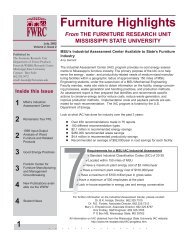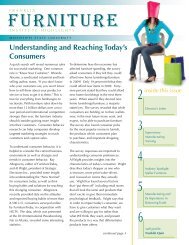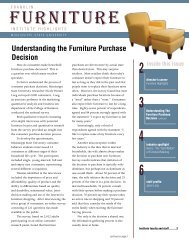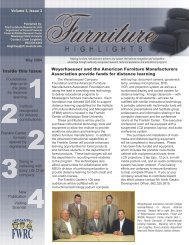Think Lean for Profitability and Sustainability - Franklin Furniture ...
Think Lean for Profitability and Sustainability - Franklin Furniture ...
Think Lean for Profitability and Sustainability - Franklin Furniture ...
Create successful ePaper yourself
Turn your PDF publications into a flip-book with our unique Google optimized e-Paper software.
/////////////////////////////////////////////////////////////////////////////////////<br />
/////////////////////////////////////////////////////////////////////////////////////<br />
/////////////////////////////////////////////////////////////////////////////////////<br />
/////////////////////////////////////////////////////////////////////////////////////<br />
/////////////////////////////////////////////////////////////////////////////////////
What exactly is lean? <strong>Lean</strong> has been defined as “a systematic approach<br />
to identifying <strong>and</strong> eliminating waste through continuous improvement,<br />
flowing the product at the pull of the customer in pursuit of perfection.”<br />
First of all, according to this definition, the approach to becoming lean<br />
should be systematic. To benefit from lean practices, a company would<br />
need to begin with an overall strategy <strong>and</strong> apply it in the correct order.<br />
Secondly, the lean strategy should focus on eliminating waste. Waste<br />
can be eliminated through inefficient processes including transportation,<br />
production delays, inventory, defective products <strong>and</strong> ineffective activities.<br />
Last of all, while absolute perfection will probably never be realized, each<br />
step to achieving continuous improvement will increase a company’s<br />
profitability <strong>and</strong> potential.<br />
August 2009<br />
Contributing Authors:<br />
Debbie Miller, <strong>Franklin</strong> <strong>Furniture</strong> Institute<br />
Ennis E. “Chip” Bailey, <strong>Franklin</strong> <strong>Furniture</strong> Institute
Manufacturers need to stay focused on<br />
finding new ways to design, produce,<br />
sell <strong>and</strong> deliver their products. Due<br />
to lower employment numbers <strong>and</strong><br />
profits, many companies have begun<br />
implementing lean manufacturing<br />
methods to gain a better position in<br />
the industry. Pressures from <strong>for</strong>eign<br />
competition have also encouraged<br />
many American manufacturers to adopt<br />
lean manufacturing processes. While<br />
simple lean logic is the idea that excess<br />
inventory is a waste, many companies<br />
implement lean more slowly than they<br />
really should, simply because they lack<br />
the measurements <strong>and</strong> tools to verify<br />
that lean is actually working.<br />
Why would anyone waste materials?<br />
Why would anyone waste space<br />
to store excess inventory? Henry<br />
Ford defined the lean concept simply:<br />
“We will not put into our establishment<br />
anything that is useless.” Types of<br />
waste can include excess inventory,<br />
overproduction, waiting time,<br />
transportation, costs of quality (scrap,<br />
rework <strong>and</strong> inspection), <strong>and</strong> other<br />
non-value adding processes. Not all<br />
manufacturers are the same <strong>and</strong> needs<br />
are dictated by specific products <strong>and</strong><br />
functions. While lean seeks to reduce<br />
<strong>and</strong> eliminate non-value business<br />
activities, it gives an overall competitive<br />
advantage by lowering operating costs<br />
while improving productivity. Here are<br />
some basic principles of lean that must<br />
be understood be<strong>for</strong>e a company can<br />
begin building lean strategies:<br />
Underst<strong>and</strong> Customer Values<br />
A company must be able to identify<br />
<strong>and</strong> establish values that are externally<br />
focused on what customers believe<br />
are important. Keep in mind that<br />
environmental <strong>and</strong> sustainability goals<br />
such as reduction of waste <strong>and</strong> use of<br />
renewable energy also serve customer<br />
interests—being lean <strong>and</strong> green could<br />
help a company reach its customers<br />
more effectively. Long-term success<br />
can only be achieved through customer<br />
satisfaction.<br />
Value Stream Analysis<br />
Steps in the business process have to<br />
be analyzed to determine which ones<br />
actually add value. If measurements<br />
aren’t taken, then it is difficult <strong>for</strong> goals<br />
<strong>and</strong> improvements to be obtained. If a<br />
step does not add value, the company<br />
should either change the step or<br />
consider removing it from the process<br />
altogether. If there is a key success<br />
factor that is not acknowledged or<br />
tracked, it may as well not exist.<br />
Measurements of added value should<br />
be in place to indicate not only<br />
financial success—profits, market
shares, <strong>and</strong> earnings growth—but<br />
also per<strong>for</strong>mance excellence such as<br />
response time to market, customer<br />
satisfaction, <strong>and</strong> outst<strong>and</strong>ing processes<br />
<strong>for</strong> quality <strong>and</strong> timeliness, mechanisms<br />
that ensure learning, growth <strong>and</strong><br />
continual improvement, <strong>and</strong> employee<br />
satisfaction. These measurements<br />
should always result in values that can<br />
be tracked, managed <strong>and</strong> improved.<br />
The non-financial measurements<br />
indicate whether the elements of<br />
success are in place—responsive<br />
time-to-market, a loyal customer base,<br />
processes that demonstrate quality <strong>and</strong><br />
timeliness, <strong>and</strong> methods that<br />
determine learning, growth <strong>and</strong><br />
continuous improvement.<br />
Per<strong>for</strong>mance quality<br />
measurements take inputs from<br />
labor, marketplace requirements,<br />
operating funds, raw materials,<br />
<strong>and</strong> supplies <strong>and</strong> determine how<br />
effectively they are converted to outputs<br />
that are valuable to customers.<br />
Supplier per<strong>for</strong>mance measurements<br />
determine the impact of overall costs of<br />
transactions, communication, problem<br />
solving <strong>and</strong> having to use multiple<br />
suppliers <strong>for</strong> the same raw materials<br />
<strong>and</strong> components. Suppliers may be<br />
substituted when one runs out of stock<br />
or when materials may be purchased at<br />
a reduced price. In addition, supplier<br />
inventory levels <strong>and</strong> delivery times can<br />
affect the supply chain per<strong>for</strong>mance.<br />
Flow<br />
Production should flow continuously<br />
from one work station to the next,<br />
beginning with raw materials <strong>and</strong> ending<br />
with the finished product. Employee<br />
involvement <strong>and</strong> teamwork, measuring<br />
<strong>and</strong> organizing processes, <strong>and</strong> reducing<br />
variation, defects <strong>and</strong> cycle times are<br />
all important methods of continuous<br />
improvement in production flow that<br />
involve an ongoing company-wide ef<strong>for</strong>t.<br />
“...eliminate steps that do not<br />
add value <strong>and</strong> improve the<br />
efficiency of those that do.”<br />
Pull<br />
Pull should be based on customer<br />
dem<strong>and</strong> rather than stockpiling<br />
inventory. Transferring to a pullbased<br />
schedule typically requires that<br />
managers ditch systems that utilize<br />
push-based scheduling, something few<br />
manufacturers are willing to do.<br />
This process can also be viewed as<br />
the “value chain” where each activity<br />
or step contributes to the end result.<br />
The entire group of activities in the
process should be organized to work<br />
together to trans<strong>for</strong>m one or more<br />
kinds of input into outputs that are<br />
valuable to customers. Inputs such<br />
as the employee’s work, marketplace<br />
requirements, operating funds, raw<br />
materials <strong>and</strong> supplies should also<br />
be converted quickly to outputs. The<br />
challenges managers face are to<br />
eliminate steps that do not add value<br />
<strong>and</strong> improve the efficiency of those that<br />
do.<br />
The cost of quality increases each time<br />
work is redone. This includes reworking<br />
the manufactured products, retesting<br />
an assembly item <strong>and</strong> the rebuilding of<br />
a tool. Prevention costs are designed<br />
to prevent poor planning, insufficient<br />
supplier capability <strong>and</strong> underestimated<br />
process capability. Failure costs result<br />
in products that do not con<strong>for</strong>m to<br />
company requirements or customer<br />
needs. Internal failure costs happen<br />
when timely product delivery to the<br />
customer fails. External failure costs<br />
occur during or after furnishing the<br />
product to a customer—customer<br />
complaints, customer returns, warranty<br />
claims <strong>and</strong> product recalls. In other<br />
words, the cost of quality is an expense<br />
that would not have occurred if the total<br />
quality of the product were accurate<br />
—or done to perfection. Companies<br />
should constantly improve processes<br />
<strong>for</strong> planning, production <strong>and</strong> service.<br />
Perfection<br />
By eliminating waste from the production<br />
process, the product begins to<br />
continuously flow according to customer<br />
dem<strong>and</strong>s <strong>and</strong> noticeable results should<br />
include reduction of time, cost, space,<br />
errors <strong>and</strong> ef<strong>for</strong>ts. Managers need to<br />
define a st<strong>and</strong>ard of problem solving so<br />
that the process can be reviewed <strong>and</strong><br />
evaluated <strong>and</strong> solutions can be easily<br />
implemented. The fact that we can<br />
strive <strong>for</strong> perfection but never achieve it<br />
makes it possible <strong>for</strong> improvement <strong>and</strong><br />
progress. But in setting a st<strong>and</strong>ard of<br />
perfection, remember that perfection<br />
is synonymous with excellence <strong>and</strong><br />
excellent quality results from perfectly<br />
processing the perfect thing, in the<br />
perfect way.<br />
Taking a <strong>Lean</strong> Stance<br />
<strong>Lean</strong> principles consist mainly of<br />
customer driven values <strong>and</strong> working<br />
together in managing waste elimination<br />
<strong>and</strong> opportunities <strong>for</strong> improvement.<br />
<strong>Lean</strong> aims to maximize a company’s<br />
overall per<strong>for</strong>mance system from<br />
concept to delivery. With lean<br />
practices, inventory is produced in small<br />
quantities <strong>and</strong> pulled as needed. Pull<br />
systems rely on a central control source<br />
to move the resources based on a<br />
plan that is maintained throughout the<br />
work<strong>for</strong>ce. Production results will then<br />
show a reduction in its work-in-process.
Peavey International is an example of<br />
one company that has embraced a<br />
company-wide lean initiative. Peavey<br />
expects to maximize efficiency among<br />
its 33 facilities <strong>and</strong> strengthen its global<br />
position by applying efficient skills,<br />
freeing up needed resources, <strong>and</strong><br />
ultimately becoming more competitive<br />
by applying lean techniques to the<br />
company’s workflow <strong>and</strong> processes.<br />
A McKinsey Quarterly report in<br />
2007 described an evolving level<br />
of management <strong>and</strong> operational<br />
competency in China. One of<br />
the aspects was that multinational<br />
companies were taking best practices,<br />
including lean manufacturing, to<br />
China. The McKinsey study of 30<br />
multinational-owned factories in China<br />
also showed that waste-reduced profits<br />
in China had increased from 20 to<br />
40 percent by using lean processes.<br />
Although waste can seem to be<br />
common in most manufacturing plants<br />
because of employee mind-sets <strong>and</strong><br />
manufacturing approaches such as<br />
inefficient distribution networks <strong>and</strong><br />
under-leveraged production processes,<br />
approaches to lean operations<br />
emphasizing high per<strong>for</strong>mance<br />
st<strong>and</strong>ards <strong>and</strong> operating precision<br />
can trans<strong>for</strong>m a company’s success.<br />
Managers will too often focus on growth<br />
instead of operational improvements<br />
when a business is growing <strong>and</strong><br />
the profits are good. Successful<br />
companies will rethink their strategies,<br />
their organizational goals, <strong>and</strong> their<br />
operations. This means learning to<br />
recognize <strong>and</strong> adopt best practices that<br />
will keep the business alive in the face<br />
of a global struggle.<br />
Manufacturers must also remember that<br />
maintaining a competitive position is<br />
“Production should flow continuously from<br />
one work station to the next, beginning<br />
with raw materials <strong>and</strong> ending with the<br />
finished product.”
about being able to satisfy dem<strong>and</strong>ing<br />
customers. The customers are clearly<br />
in charge. Leading manufacturers have<br />
learned how to respond to last minute<br />
configuration changes without additional<br />
lead times to fulfill an order. In most<br />
cases, this requires a culture change<br />
within the organization. Edgar Schein<br />
defines organizational culture as “A<br />
pattern of shared basic assumptions<br />
—to be taught as the correct way to<br />
perceive, think <strong>and</strong> feel” <strong>and</strong> is the most<br />
difficult attribute to change. Success<br />
is progressively more about how well<br />
a business works, how fast it can act<br />
<strong>and</strong> its ability to per<strong>for</strong>m in the face of<br />
today’s challenges. Meeting headon<br />
with the frequent <strong>and</strong> unexpected<br />
changes in supply, dem<strong>and</strong>, capacity<br />
<strong>and</strong> product engineering, establishing a<br />
competent system that enables supply<br />
chain agility <strong>and</strong> operations per<strong>for</strong>mance<br />
is the key to success where problems<br />
can be complex, where change is<br />
constant, <strong>and</strong> time matters.<br />
A st<strong>and</strong>ard of problem solving must<br />
be defined so that leadership can<br />
effectively guide others when difficulties<br />
do arise. For leadership to occur,<br />
leaders must communicate the vision<br />
to others in such a way that the vision<br />
is adopted as their own, <strong>and</strong> thus<br />
promotes continuous improvement.<br />
Continuous improvement is an<br />
ongoing ef<strong>for</strong>t to improve products,<br />
services <strong>and</strong> processes. Managers<br />
must plan <strong>for</strong> changes, implement<br />
changes, analyze results of changes,<br />
<strong>and</strong> continuously assess the results<br />
of the change to determine whether it<br />
can be implemented on a wider scale.<br />
Managers must also learn to focus on<br />
the warning indicators of problems,<br />
recognize setbacks when they occur,<br />
evaluate the possible impact, <strong>and</strong><br />
quickly identify solutions. A road map of<br />
alternative solutions should be available<br />
<strong>and</strong>, in the end, the desired results<br />
should be achieved by highly-trained<br />
<strong>and</strong> skilled problem solvers. Feedback<br />
must be built into the implementation of<br />
solutions to develop effective monitoring<br />
<strong>and</strong> analysis of actual processes <strong>and</strong> to<br />
align them with company expectations.<br />
Companies should also consider a<br />
system that allows them to predict<br />
the effect of changes in dem<strong>and</strong> on<br />
operating capacities <strong>and</strong> workloads. In<br />
many cases a gradual transition to an<br />
in<strong>for</strong>mal or matrix type organizational<br />
structure will enhance the ability to<br />
respond. Additionally, these types<br />
of organizational structures will<br />
promote decision making, increase<br />
responsibility <strong>and</strong> facilitate cooperation<br />
with in<strong>for</strong>mation technology systems<br />
to effect expedient response times.<br />
With the help of in<strong>for</strong>mation technology<br />
systems <strong>and</strong> software, orders can<br />
be released at a level pace that will
not swamp production resources. In<br />
helping to shorten lead times <strong>and</strong><br />
improve on-time delivery, an effective<br />
in<strong>for</strong>mation technology planning system<br />
can support lean by configuring the<br />
manufacturing plant properly with<br />
tools such as process optimization<br />
technology, simulation programs,<br />
plant layout, automated production<br />
equipment <strong>and</strong> creating improved lines<br />
in operation.<br />
Strategic management tools should be<br />
in place to set product <strong>and</strong> process<br />
st<strong>and</strong>ards, to develop value-added<br />
measurements <strong>and</strong> to collect <strong>and</strong><br />
analyze organizational per<strong>for</strong>mance.<br />
Customer satisfaction, business<br />
approaches <strong>and</strong> ongoing improvement<br />
strategies create the future value of<br />
companies with their customers,<br />
their suppliers, their employees, <strong>and</strong><br />
their technological <strong>and</strong> innovative<br />
processes. At the end of the day,<br />
coping with complexity <strong>and</strong> change<br />
comes down to a sequence of tradeoffs<br />
<strong>and</strong> compromises that should be<br />
determined by the best in<strong>for</strong>mation<br />
available. With the right<br />
technologies <strong>and</strong> tools,<br />
significant breakthroughs<br />
in operating per<strong>for</strong>mance<br />
<strong>and</strong> customer service can<br />
determine a company’s profit<br />
margins.<br />
<strong>Lean</strong> <strong>and</strong> Green Trends<br />
Industry pioneers in the ecomovement<br />
are being joined each year<br />
by newcomers who dedicate their<br />
resources to the planet preservation<br />
cause <strong>and</strong> offer more earth-friendly<br />
product options. This is the perfect<br />
opportunity <strong>for</strong> companies to position<br />
themselves in being “green” <strong>and</strong> saving<br />
the planet while being “lean” <strong>and</strong> saving<br />
customers <strong>and</strong> their business money.<br />
Thanks to globalization, rapid advances<br />
in technology, <strong>and</strong> the green movement,<br />
the manufacturing environment must<br />
stay focused on finding new ways<br />
to design, produce, sell <strong>and</strong> deliver<br />
products that are cost effective while<br />
being socially responsible. By focusing<br />
on the elimination of environmental<br />
waste through the use of lean<br />
processes, companies using lean<br />
techniques to achieve environmental<br />
sustainability should profit from finding<br />
ways that improve their bottom line<br />
along with their overall health <strong>and</strong><br />
sustainability.<br />
“...combining lean <strong>and</strong> green<br />
can benefit the company’s<br />
bottom line...”
A lean company uses processes<br />
that are as efficient as possible<br />
to reduce their costs. A green<br />
company uses processes that are<br />
as efficient as possible to increase<br />
their environmentally-friendly benefits.<br />
Leaders everywhere are focused<br />
on an organizational structure that<br />
incorporates continuous improvement<br />
resulting in approaches that are faster,<br />
better <strong>and</strong> less expensive. Because<br />
businesses are accustomed to treating<br />
environmental practices as a source of<br />
added costs, the challenge is to identify<br />
where environmental <strong>and</strong> sustainability<br />
quality issues, such as use of renewable<br />
energy, fewer chemicals, <strong>and</strong> the<br />
reduction of waste, will also support<br />
business <strong>and</strong> customer interests. <strong>Lean</strong><br />
<strong>and</strong> green companies aim at eliminating<br />
waste in every area including customer<br />
service, product design, supplier<br />
networks <strong>and</strong> plant management.<br />
By using less employee ef<strong>for</strong>t, less<br />
inventory, less time to develop products<br />
<strong>and</strong> less space to respond to customer<br />
dem<strong>and</strong>s, lean companies are able to<br />
produce high quality products in the<br />
most efficient <strong>and</strong> cost-effective manner<br />
possible.<br />
Of course, both lean <strong>and</strong> green<br />
must be thought of <strong>for</strong> the long term.<br />
Companies must find solutions <strong>for</strong><br />
both short-term <strong>and</strong> long-term effects<br />
on social responsibility, environmental<br />
per<strong>for</strong>mance, eliminating waste through<br />
continuous improvement, <strong>and</strong> favorable<br />
business results. Searching <strong>for</strong> best<br />
practices <strong>and</strong> establishing the best<br />
possible industry processes that are<br />
lean <strong>and</strong> green will lead to superior<br />
per<strong>for</strong>mance <strong>and</strong> company profitability.<br />
McClarin Plastics has been using lean<br />
manufacturing since 2000 <strong>and</strong> regularly<br />
realizes green benefits through waste<br />
reduction, energy conservation <strong>and</strong><br />
space allocation, <strong>and</strong> to no surprise,<br />
has seen their cash flow multiply.<br />
Through lean practices, they have freed<br />
up 30,000 square feet of warehouse<br />
space <strong>and</strong> utilized it as production<br />
space <strong>for</strong> just-in-time raw materials that<br />
are delivered directly to their plant. They<br />
have eliminated the need <strong>for</strong> warehouse<br />
expansion; thereby conserving l<strong>and</strong> <strong>and</strong><br />
resources, as well as reducing man<br />
hours <strong>and</strong> energy needed to transfer<br />
components from one work area to the<br />
next.<br />
With a focus on waste, companies<br />
can create a bridge to lean <strong>and</strong> green<br />
to be adopted by all employees on a<br />
daily basis. One way to accomplish<br />
this is through recycling—energy,<br />
water, materials, etc. By using<br />
environmentally-friendly materials in<br />
products <strong>and</strong> packaging, a company<br />
can also minimize costs of energy<br />
<strong>and</strong> resources. <strong>Think</strong> about it. When
a company becomes more energy<br />
efficient, it becomes greener. If the<br />
company is cutting costs by becoming<br />
more efficient, it becomes leaner. In<br />
the end, combining lean <strong>and</strong> green<br />
can benefit the company’s bottom<br />
line, creating a more efficient <strong>and</strong><br />
environmentally-conscious organization<br />
that will benefit everyone in the company<br />
from the top down.
References:<br />
Womack, et al., The Machine That Changed the<br />
World, 1990<br />
www.peavey.com/new/article.crfm/action/view/<br />
id/404/cat/2/article.cfm<br />
www.mcclarinplastics.com
If you would like<br />
more in<strong>for</strong>mation<br />
on the <strong>Franklin</strong><br />
<strong>Furniture</strong> Institute,<br />
check out<br />
our website at<br />
ffi.msstate.edu<br />
or contact:<br />
Bill Martin<br />
Director<br />
662.325.3348<br />
wmartin@msstate.edu<br />
or<br />
Amy Garrard<br />
Outreach Coordinator<br />
662.325.8453<br />
amy.garrard@msstate.edu<br />
FRANKLIN<br />
<strong>Furniture</strong><br />
INSTITUTE<br />
Discrimination based upon race, color, religion, sex, national origin, age, disability,<br />
or veteran’s status is a violation of federal <strong>and</strong> state law <strong>and</strong> MSU policy <strong>and</strong> will<br />
not be tolerated. Discrimination based upon sexual orientation or group affiliation<br />
is a violation of MSU policy <strong>and</strong> will not be tolerated.











